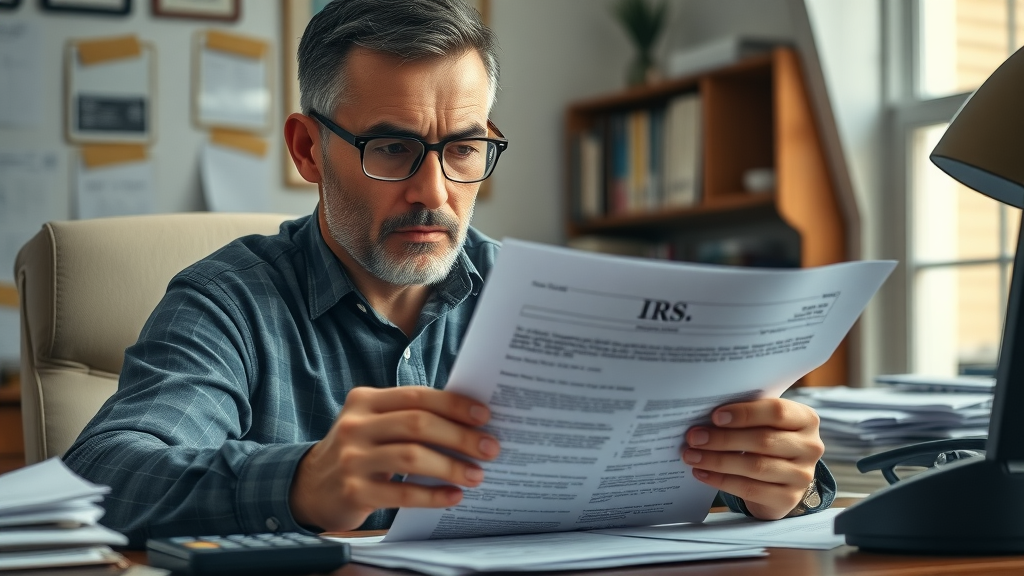Did you know? Over 16 million Americans owed back taxes in 2023, causing a record surge in IRS payment plan requests. Tax debt can happen to anyone — and if you’re feeling overwhelmed by a tax bill, you’re not alone. Fortunately, the IRS offers payment plans (also known as installment agreements) that can help you regain control, avoid harsh penalties, and resolve your balance on manageable terms. In this guide, you’ll discover how these payment plans work, who qualifies, the step-by-step setup process, and why working with an enrolled agent may be your best path forward.
Startling IRS Debt Facts: Why a Payment Plan with IRS Matters
“In 2023, over 16 million Americans owed back taxes, prompting a surge in requests for IRS payment plans and installment agreements.”
Owing tax debt to the IRS is more common than many think, and the consequences of ignoring it can be severe. Serious penalties, interest and penalties that continue to accrue, wage garnishments, or even liens can quickly make your financial situation worse. By establishing a payment plan with the IRS, you gain a structured, legal path to settle your debt over time and protect yourself from escalation. IRS payment plans give taxpayers a crucial lifeline, breaking big balances into affordable monthly payments, and providing peace of mind during stressful times.

What You'll Learn About Setting Up a Payment Plan with IRS
- How IRS payment plans and installment agreements work
- Key requirements and eligibility
- Step-by-step payment plan application process
- How enrolled agents assist with negotiations and compliance
- What happens if you can't make your monthly payment with the IRS
- Tips for avoiding penalties and interest
Understanding IRS Payment Plan Options
What is a Payment Plan with IRS?
A payment plan with the IRS—officially called an installment agreement—is a legal agreement that lets you pay your overdue tax bill over time instead of all at once. It’s designed for taxpayers who can’t pay their balance due in full by the due date. When you set up a payment plan, the IRS allows you to break the total into smaller, more manageable monthly payments. These plans help individuals, households, and even businesses tackle tax debt without extra financial strain. However, it’s crucial to keep up with payments and understand how interest and penalties might accrue during the life of the agreement.

Types of IRS Payment Plans: Installment Agreements, Short-Term, and Long-Term
The IRS offers several payment plan options depending on how much you owe and how quickly you can pay. The major types include short-term plans (full payment within 180 days), long-term installment agreements (monthly payments for more than 180 days), and partial pay agreements (for those who can’t pay the full amount at all). Short-term plans are typically available if you owe less than $100,000, while long-term agreements have a lower threshold—often below $50,000. It’s important to review which plan matches your financial situation and the required monthly payment for each option. Notably, each plan type can carry different setup fees and application procedures, making an understanding of these differences essential before you apply.
Comparing Payment Options and IRS Installment Agreements
Choosing the right IRS payment plan boils down to your eligibility, how much tax debt you owe, and your ability to make timely monthly payments. Here’s a comparison of the most common types of IRS payment options:
| Payment Plan Type | Monthly Payment | Setup Fee | Eligibility | Application Method |
|---|---|---|---|---|
| Short-Term Payment Plan | Full within 180 days | $0 | <$100,000 total tax due | Online/Phone/Mail |
| Long-Term Installment Agreement | As low as $25/mo | Up to $225 | <$50,000 owed | Online/Phone/Mail |
This table shows the differences in plan length, payment amounts, setup fees, and who qualifies. By weighing each payment option, you can identify the plan that best fits your financial and tax position.
Do You Qualify for a Payment Plan with IRS?
Eligibility Requirements for IRS Installment Agreements
Not everyone qualifies for every payment plan with the IRS. Eligibility depends on your tax debt, balance due, prior compliance, and sometimes your income tax filing status. Generally, if you owe less than $50,000 in combined tax, penalties, and interest, and have filed all required tax returns, you may qualify for a streamlined long-term IRS installment agreement. If you owe less than $100,000, you might be eligible for a short-term plan. Businesses can also qualify for certain payment agreements if their balance due is under $25,000. Ensuring you meet these qualifications is vital before applying, as denied applications can trigger further IRS scrutiny and delay resolution.

Can You Set Up a Payment Plan Online?
Yes, many taxpayers can use the IRS Online Payment Agreement tool to establish a payment plan. If your tax debt and balance due are under threshold limits (typically $50,000 or less), you can set up a long-term installment agreement entirely through the official website—no phone calls or mail required. For larger balances or more complex arrangements (like partial pay agreements), you may need to call or submit Forms 9465 and 433-F by mail. Online payment is convenient, but have all your personal information, tax return details, and bank account data ready before you begin. Setting up your IRS payment plan online is fast, secure, and puts you on the path to tax debt resolution.
Income Tax and Balance Due Guidelines
Your total income tax owed and balance due play a significant role in which IRS payment plan options are available to you. If you owe less than $50,000 and have no outstanding unfiled tax returns, you’re eligible for most streamlined installment agreements. Owe more? The IRS will request extra financial documentation and may require you to work with an enrolled agent or tax pro. Always verify your tax return accuracy and confirm your exact balance due before applying, because late or incorrect filings can disrupt your IRS payment plan approval.
Step-by-Step Guide: How to Set Up a Payment Plan with IRS
How to Use the Online Payment Agreement Tool
The IRS Online Payment Agreement tool is the easiest way for most people to set up a payment plan. Start by visiting the IRS’s official website, then log in using your financial details and tax return information. The tool will guide you to enter your balance due, propose a monthly payment amount, and select your preferred payment option (such as direct debit or credit card). Before submitting, double-check all entries for accuracy—mistakes could delay approval or cause you to lose eligibility. After application, you’ll receive a confirmation, and your first monthly payment will be debited or due on the specified date. This process is secure, efficient, and designed for easy navigation even if you aren’t a tax pro.
Application Process for an Installment Agreement
To apply for an IRS installment agreement (whether online, by phone, or mail), follow these steps: First, confirm you have filed all required tax returns. Gather your tax bill or IRS notice, social security or ITIN, mailing address, and employer or bank account details. Next, choose your preferred payment option and calculate a realistic monthly payment. Then, apply via the Online Payment Agreement tool, IRS phone service, or by submitting Form 9465. The IRS will review your application, and if it matches their eligibility requirements, they’ll notify you of approval—often within hours for online requests. Stay alert for IRS correspondence, as you’ll need to acknowledge your agreement terms and respond to any additional information requests.
Documents and Details You'll Need
- Recent tax return and tax bill details
- SSN or ITIN, filing status, address, and contact information
- Bank account and employer details

Monthly Payments: Calculating Your IRS Payment Plan Amount
How Your Monthly Payment is Determined
Your monthly payment amount for an IRS payment plan is based on your total tax debt, the amount of your balance due, and your ability to pay. The IRS may allow low amounts (as low as $25/month) for lower debts under a standard installment agreement. You’ll propose a reasonable payment amount on your application, but be prepared to justify it—especially for higher debts or longer agreements. The IRS can request supporting documents on income tax, living expenses, and assets to ensure your payment is manageable. Remember, interest and penalties continue to accrue until your debt is paid in full, so pay as much as possible each month to save money over time.

Payment Methods: Direct Debit, Credit Card, and More
The IRS offers several payment options for your installment agreement. Direct debit from your bank account is the most popular and the lowest-cost method—minimizing risk of missed payments and additional penalties and interest. You can also pay by credit card, check, money order, or through online payment services, but these may come with additional setup fees or third-party charges. Choosing direct debit can help you avoid lapses in your monthly payment and ensure you keep your IRS payment plan in good standing—even when life gets busy.
IRS Setup Fees and Penalties
Establishing an IRS payment plan often means paying a setup fee. Short-term plans (under 180 days) don’t require a fee, but long-term agreements can cost up to $225 if you pay by check or $31 for online, direct debit agreements. If you miss a monthly payment or default, additional penalties and interest will continue to accrue on your balance due. Choosing the cheapest payment option and sticking with scheduled payments help minimize the total cost of your IRS installment agreement.
The Role of Enrolled Agents in Navigating IRS Payment Agreements
How an Enrolled Agent Can Help You with Tax Payment Plans
“Enrolled agents are federally-authorized tax practitioners who can act on your behalf before the IRS, ensuring you secure the most favorable installment agreement possible.”
A certified enrolled agent (EA) is your tax negotiation ally. EAs have the credentials and IRS experience to advocate for you, whether you’re seeking basic payment plans or need help with complex tax relief options. Enrolled agents review your finances, assess your eligibility, propose ideal monthly payments, and negotiate payment terms with the IRS on your behalf. Their training, ethics, and continuing education requirements mean they know current IRS rules, potential pitfalls, and the latest changes to installment agreement procedures. Having an EA on your side often results in less paperwork, faster approvals, and payment terms that fit your real financial situation.
Negotiating Payment Amount and Terms
When working with an enrolled agent, one of the greatest advantages is their ability to negotiate with the IRS about your payment plan. EAs understand the IRS’s policies, so they know how to present your case for lower monthly payments, waivers of some setup fees, or even alternative payment options. If your financial situation changes, your EA can help you request adjustments, review bank account withdrawals, or pause payments for emergencies—all while keeping your IRS installment agreement active and compliant.

Handling IRS Correspondence and Compliance
The paperwork that comes with IRS payment plans can be overwhelming. An enrolled agent helps you interpret IRS letters, respond by due date, and submit required documentation on time. They track compliance, reminding you of monthly payment schedules and filing deadlines. By working with an EA, you avoid common mistakes that can result in default and keep you on the best path toward tax debt freedom. If the IRS questions your payments or requests more info, your EA acts as your direct representative, ensuring communication is clear, complete, and in your best interest.
Explainer: The Process of Setting Up a Payment Plan with IRS
What If I Can't Afford My IRS Payment Plan?
Alternative Payment Options with the IRS
If making your agreed-upon monthly payment becomes impossible, don’t panic—but do act quickly. The IRS offers alternatives: temporarily pausing your installment agreement (if you prove financial hardship), entering into a “currently not collectible” status, or negotiating lower monthly payments. You might also qualify for Offer in Compromise or Partial Pay Agreements if you can demonstrate inability to pay the full amount. In every case, prompt action—preferably with help from an enrolled agent—reduces penalties and prevents more serious collection actions like liens or levies.
Dealing with Penalties and Interest
As long as you owe a balance due, interest and penalties continue to accrue on unpaid tax debt. Missing a monthly payment on your IRS payment plan can trigger default, higher setup fees, and the restarting of collection activity. If you’re at risk, work with a tax pro or enrolled agent immediately—they can negotiate reinstatement or alternative options. Requesting abatement of penalties and interest is sometimes possible for first-time offenders or those with solid cause, but requires timely documentation and formal requests.
Offer in Compromise and Partial Pay Agreements
For truly unaffordable tax debt, an Offer in Compromise (OIC) may allow you to settle with the IRS for less than the full amount owed. Alternatively, Partial Pay Agreements set up monthly payments based on your ability—not your total balance due. Both options require strict eligibility and substantial proof of financial hardship. Engaging an enrolled agent maximizes your chances of approval and ensures that your application reaches the IRS in top shape.
People Also Ask About Payment Plan with IRS
Will IRS give you a payment plan?
Yes, the IRS offers payment plans—also known as installment agreements—to most taxpayers who owe less than $50,000 and are current on their tax filing. If you can’t pay your tax bill in full by the due date, setting up an IRS payment plan is a smart way to avoid further penalties and keep collection actions at bay. Even if you owe more, the IRS can sometimes approve payment plans with additional documentation and negotiation, especially when working through an enrolled agent.
What is the minimum payment the IRS will accept?
The IRS doesn’t specify a universal minimum monthly payment; it depends on your tax debt, financial situation, and the plan you select. For lower debts, payments can be as low as $25/month. However, you should always propose the highest amount you can afford, as paying more each month reduces your total interest and penalties. Underestimating your payment may result in a request for more documentation or a rejected agreement.
How long will the IRS do a payment plan?
You can set up an IRS payment plan for up to 72 months (six years), depending on your balance due and installment agreement type. Short-term payment plans (under 180 days) require full payment within that period, while long-term agreements stretch up to the maximum available timeframe. If your situation changes, you or your enrolled agent can request modifications to your plan.
What if I owe the IRS but can't afford to pay?
If you’re unable to pay your tax bill in full, don’t ignore the problem. Apply for an IRS payment plan, partial pay agreement, or see if you qualify for an Offer in Compromise. Communicate with the IRS or a tax pro immediately to avoid garnishments, liens, or accruing penalties. Taking prompt action is the key—and professional help can make all the difference.
Expert Tips: Working with Enrolled Agents to Resolve IRS Tax Debts
Frequently Asked Questions About Payment Plans with IRS
-
Can having an IRS payment plan affect my credit score?
Typically, the IRS does not report payment plans or tax debts to credit bureaus. However, if a tax lien is filed, it may appear on your credit report and lower your score. Timely monthly payments on your plan help avoid liens and credit impacts. -
What happens if I miss a monthly payment?
Missing a monthly payment can put your installment agreement in default, prompting the IRS to resume collection efforts and add more interest and penalties. If you miss a payment, contact the IRS or your enrolled agent immediately to negotiate a reinstatement. -
Are IRS online payment agreements safe?
Yes, the IRS uses secure encryption for all online payment agreement applications. As long as you use the official website and protect your login information, your data is secure. -
How do I change my payment plan or request a lower payment?
You can request a change by contacting the IRS directly or using your IRS online account. If your financial situation changes, an enrolled agent can help you gather documentation and submit a formal request for plan modification.
Key Takeaways on Setting Up a Payment Plan with IRS
- IRS payment plans provide manageable ways to resolve tax debt.
- Eligibility depends on your balance due and your filing status.
- An enrolled agent streamlines the application process and improves outcomes.
- Always review payment options and penalty risks.
Conclusion: Take Action to Resolve Your IRS Tax Debt
Don’t let tax debt put your finances at risk. Setting up a payment plan with the IRS is practical, effective, and easier with expert help.
Need Expert Help? Set Up Your Payment Plan with IRS Today
Need help with the IRS? Call us at (479) 926-1040. Don’t tackle the IRS alone. Our enrolled agents can help you.
If you’re looking to set up a payment plan with the IRS, the agency offers several options to help taxpayers manage their tax debts. The IRS provides both short-term and long-term payment plans, depending on the amount owed and the time frame in which you can pay. For instance, if you owe less than $100,000, you may qualify for a short-term payment plan, allowing you to pay your balance in full within 180 days. Alternatively, if your debt is $50,000 or less, a long-term installment agreement enables you to make monthly payments over an extended period. (irs.gov)
To apply for a payment plan, you can use the IRS’s Online Payment Agreement tool, which requires you to log in with your IRS username or ID.me credentials. This online application is convenient and provides immediate notification of approval. If you prefer, you can also apply by phone, mail, or in person. (irs.gov)
It’s important to note that setting up a payment plan may involve certain fees. For example, a long-term payment plan with automatic withdrawals has a setup fee of $22 if applied for online, while applying by phone, mail, or in person incurs a $107 fee. Low-income taxpayers may qualify for reduced or waived fees. (nerdwallet.com)
Additionally, interest and penalties will continue to accrue on your unpaid balance until it’s fully paid. Therefore, it’s advisable to pay as much as possible each month to minimize these additional costs. (turbotax.intuit.com)
If you’re unable to make your agreed-upon monthly payments, it’s crucial to contact the IRS immediately to discuss alternative arrangements, such as modifying your payment plan or exploring options like an Offer in Compromise. (findlaw.com)
For more detailed information and to apply for a payment plan, visit the IRS’s official website. (irs.gov)
 Add Row
Add Row  Add
Add 



Write A Comment